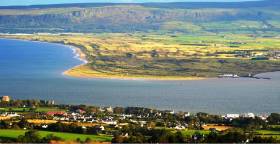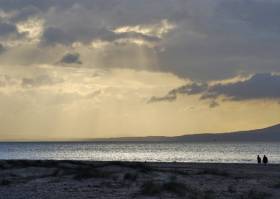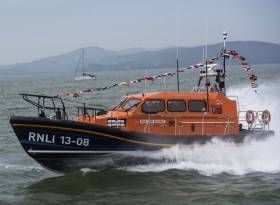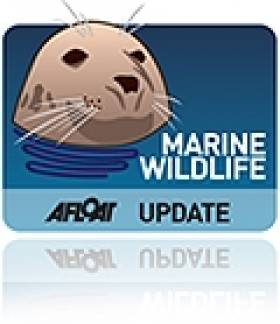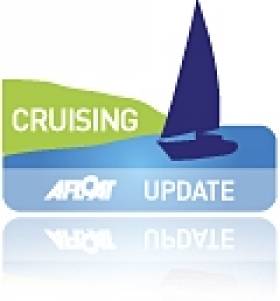Displaying items by tag: Lough foyle
Marine Minister Takes On Donegal Supertrawler Fleet Over Multimillion Euro Mackerel Fishery
#TerritorialWaters - Marine minister Michael Creed writes The Irish Times faces a clash with the influential Donegal supertrawler fleet following his decision to review the share-out of the lucrative mackerel fishery.
Mr Creed has also said he was committed to legislation allowing northern and southern fishing vessels reciprocal fishing rights within the island’s territorial waters, in spite of opposition within the industry.
He has also warned of a “very real problem” if Westminster “puts a ring around its territorial waters” when it leaves the EU, given that 38 per cent of Irish catches are in British waters.
The Cork North-West TD secured a 6 per cent overall increase in Irish fish quotas for this year in Brussels last month, including an additional mackerel allocation valued at about €10 million.
Mackerel is Ireland’s most important commercial fishery, with a value of €64 million last year for the Irish fleet, according to Bord Iascaigh Mhara.
Mr Creed conceded to a request from the Irish South and West Fishermen’s Organisation to review the share-out of an additional quota.
The move has been criticised by the Killybegs Fishermen’s Organisation, representing the Donegal-based fleet that pioneered the hunt for the valuable migratory stock –and which has held up to 87 per cent of the annual share-out.
For more click here including about four mussel fishermen who as previously covered on Afloat took legal action that led to a Supreme Court ruling in their favour.
A Brexit Thought – Who Owns Lough Foyle?
The Secretary of State for Northern Ireland had a lot more than maritime matters on his mind this past week…. So he probably wasn’t giving a lot of thought to Lough Foyle as the Northern Assembly collapsed.
Neither, I suggest, was the British Prime Minister, Theresa May, when she announced how the UK will perform its Brexit from the EU.
I don’t think our Taoiseach, Enda Kenny, was either and probably not our Minister for Foreign Affairs, Charlie Flanagan.
But, they should give Lough Foyle a lot of thought…
James Brokenshire claims that the whole of Lough Foyle is within the UK…. And as Secretary for Northern Ireland that’s an important claim…..
The Irish Department of Foreign Affairs says that Ireland does not accept that claim.
The Northern Ireland Office, under UK administrative control, cites a 1662 Charter of Charles the Second which included “the waters and bed, as well as the fisheries” of the Lough as part of County Londonderry….
Derry, of course, if you see it with Irish Nationalistic eyes…..
Lough Foyle is the estuary of the River Foyle separating Northern Ireland from the Republic, but the British claim to the entire Lough could take its rights up to the shores of the Republic and what will that do for such as the fisheries, for example, when the UK intends to take control of those back from the EU during its Brexit….
The Good Friday Agreement created the Loughs Agency as a cross-Border body for the Foyle.. so where does it stand in the context of Brexit?
Just though I’d mention it in the context, of course, of the past week…
Waterford Ferries: From Falklands Conflict to Foyle’s War
#FerryDiplomacy – Former Celtic Link Ferries first ship that in another guise took part in the Falklands Conflict, had ended her Irish career in 2010 laid-up in Waterford is where at the exact berth is docked since last week a Lough Foyle ferry, writes Jehan Ashmore.
The Celtic Link Rosslare-Cherbourg ro-ro freight-ferry, Diplomat (1978/16,766grt) had vehicle decks for around 82 freight-units. In addition to carrying around 80 passengers. CLF acquired the joint passenger-freight service from P&O European Ferries when they closed their Rosslare-Cherbourg route 12 years ago in December 2004.
P&O's European Diplomat (originally launched as Stena Trader) was renamed by CLF that was owned by the O’Flaherty Brothers of Kilmore Quay. For more on their fish /shipping connected business click here. It was pleasing to see an Irish owned ferry company competing with the established continental serving operators.
Almost full circle as Stena Line acquired CLF in 2011 whom previously deployed Diplomat (see report photo at Waterford) on charter in the Caribbean and replaced by chartered Norman Voyager. A second charter replacement followed in the form of Celtic Horizon (see final voyage report here) since renamed Stena Horizon.
The Italian built ropax Stena Horizon recently underwent a refurbishment upgrade to closer match level of passenger facilities found elsewhere in the Stena fleet. In recent years refurbishments were applied to sisters Stena Lagan and Stena Mersey serving Belfast-Birkenhead (Liverpool). The pair were introduced as newbuilds more than a decade ago for NorseMerchant Ferries.
Falklands ‘Conflict’
Diplomat as previously mentioned was the Stena Trader built in 1978 for Stena Rederi as one of 11 successful ‘Searunner’ South Korean class freight-ferry sisters. She was soon renamed Stena Transporter and from thereon a chequered career involving many charters and names changes. Most notably was her historic role in the Falklands Island ‘conflict’ war with Argentina in 1982.
The UK Ministry of Defence having requisitioned the ship then named Baltic Ferry. The Townsend Thoresen North Sea serving ferry became part of the Falkland Islands Task Force that included HMS Illustrious. In recent weeks the final ‘Invincible’ class aircraft carrier bade her homeport of Portsmouth Naval Base farewell. This saw HMS Illustrious under tow bound for a Turkish scrapyard.
The deployment of Baltic Ferry saw her upper vehicle freight deck (see photo above of Diplomat) modified with a pair of helicopter pads. In addition it was from this deck that the ship saw action by Royal Air Force Harrier Jump-Jets using the aircraft's unique vertical take-off lift (VTOL) capability.
In addition Baltic Ferry on the deployment delivery voyage had on board troops with replenishment at sea equipment prior to the long distance voyage to the South Atlantic. She set sail along with sister Nordic Ferry to the far flung colonial outpost. The ship was service in San Carlos waters of the Falklands and later was stationed in the capital of Port Stanley as a stores ship.
A plaque in recognition of the freight-ferry’s role in the war was noted during my port visit.
A Diplomatic Voyage
An opportunity arose in 2008 having requested CLF to conduct a first ever interview with a captain and that on board a ship. Another reason for the request was Diplomat’s unique Ireland-France ‘freight-ferry service’ days were numbered given the ageing vessel.
The freight-ferry departed Rosslare though the interview took place in the busy English Channel. This all added to the experience of interviewing the master, Captain Ivan Walsh published Ships Monthly, November 2009. The interview also allowed for photography having joined the procession of the eastbound traffic shipping lane before veering off for Cherbourg.
Upon arrival at Cherbourg, a speedy disembarkation was required to make a train connection to another Normandy port, Caen (Oustreham). This was to enable English Channel crossings with Brittany Ferries. They involved sailing to Portsmouth on Normandie but returning to France out of Poole on Barfleur for Cherbourg. All forming part of a three-route ‘working’ holiday.
In reflecting on the Diplomat interview now it is noted that Captain Walsh early career cadetships was that with the former Bell Lines. The Irish based lo-lo container operator whose Waterford Port terminal at Frank Cassin Wharf is where Diplomat had spent the layup. On completion of the Carribean charter Diplomat was sold and renamed Pavilon for scrapping at Alang, India in 2011.
As for the Foyle Venture as mentioned in the introduction she is berthed at the exact berth of Diplomat. This is along the underused city quays lining the River Suir.
A second on board interview regarded the final leg to Ireland with Irish Ferries cruiseferry Oscar Wilde. This was published in Ships Monthly, August 2009. The interview was conducted with master, Captain John Grace who talked about the ship’s continental service and the role of his crew and working patterns.
Ironically both masters would later be working together in the early days of Fastnet Line’s Julia on the Cork-Swansea route. Afloat had an opportunity to make a round-trip in the first year of the short-lived service but at that stage another master was in command.
Foyle’s War
Incidentally, Oscar Wilde features on the new owner's website of the Passage East Ferry Company, which Afloat covered the sale to Fraser Ferries earlier this year. The promotional video showcases the tourism attractions of the sunny south-east.
Only last week was where the Waterford Estuary service saw Lough Foyle Ferry Company’s Foyle Venture carrying out ‘berthing’ trials.
This took place in tandem of the River Suir’s routine ferry FBD Tintarn (1978/325grt). The former German ferry shuttles between Passage East, Co. Waterford and Ballyhack, Co. Wexford.
As Afloat covered the issue of Brexit that raised dormant territorial dispute between Britain and Ireland over the ownership of Lough Foyle.
The estuary between Counties Donegal and Derry is under the auspices of the cross-border Loughs Agency since the Good Friday Agreement.
In addition there is also uncertainty on Lough Foyle and Carlingford Lough between counties Louth and Down over fishing rights as the UK prepares to leave the EU and the Common Fisheries Policy.
On a related note to ferry developments, Fraser Ferries was given the go-ahead in 2015 for a new Carlingford ferry route despite local objections.
Brexit Revives Dispute Over Lough Foyle Territory Rights
#Brexit - Brexit has revived a dormant territorial dispute between Britain and the Republic of Ireland over the ownership of Lough Foyle, as the Belfast Telegraph reports.
Leinster House has rejected a claim by Northern Ireland Secretary James Brokenshire that the UK includes the whole of the estuary between Counties Donegal and Derry, which has been under the auspices of the cross-border Loughs Agency since the Good Friday Agreement.
Lough Foyle and Carlingford Lough, between Counties Louth and Down, are both matters of dispute between Dublin and London which have only intensified with the uncertainly over fishing rights as the UK prepares to leave the EU and the Common Fisheries Policy.
The Belfast Telegraph has more on the story HERE.
Major Marine Rescue Demo On Lough Foyle This Weekend
#Rescue - Moville on the shores of Lough Foyle is set to host a major marine rescue demonstration this coming weekend, as Inishowen News reports.
Naval Service vessel LÉ Orla will join Air Corps aircraft, the Irish Coast Guard, Lough Swilly RNLI, Foyle Rescue and more for the Irish Marine Search and Rescue Demo (IMSARC) on Saturday 16 July.
Events commence at 1.30pm on the day with water-based demonstrations by the coastguard helicopter, drone aircraft and others, while on land, mountain rescue teams will go through the basics of dangerous cliff-face operations.
The weekend continues with the Clipper Family Fun Day in nearby Greencastle on Sunday 17 July from 3pm-5pm, part of a week of celebrations for the Foyle Maritime Festival awaiting the arrival of Derry~Londonderry~Doire and the rest of the Clipper Race fleet.
Inishowen News has a full rundown of the IMSARC itinerary HERE.
Suspended Jails Terms Over Illegal Sea Defences On Lough Foyle
#CoastalNotes - Unauthorised sea defences on Lough Foyle have landed two men with suspended prison sentences, as the News Letter reports.
David McCullough of Ballymena and Gregory Allen of Limavady were found to have built sea defences using 20,000 waste tyres at a site in Bellarena, south of Magilliagn Point on the east coast of the lough, without a licence from the Northern Ireland Environment Agency.
District judge Liam McNally said the offence was "very serious" as he handed down four-month sentences suspended for two years at Limavady Magistrate’s Court on Wednesday 18 November.
The News Letter has more on the story HERE.
Minke Whale Calf Beaches On Lough Foyle Shore
#MarineWildlife - A minke whale calf has died after beaching on the shore of Lough Foyle near Limavady last week, as BBC News reports.
The whale, thought to be just three months old, was first spotted by locals washed up on the beach in Myroe on Friday 29 May and was encouraged back into the sea, but was later found deceased in an emaciated condition on Tuesday 2 June.
"We assessed the situation and noted that the animal was an unweaned calf about three months old and apparently separated from its mother," said a spokesperson for Norther Ireland's Department of Environment, which has since removed the carcass.
"The calf was severely malnourished and had suffered extensive injuries during its several standings."
The spokesperson confirmed that there is no correlation between this stranding and the recent mass stranding of pilot whales off the Isle of Skye in western Scotland.
According to the Irish Examiner, nine were lost from the group of 21 whales that beached at Staffin in the north east of the Inner Hebridean island on Tuesday 2 June.
The incident is the worst since 16 pilot whales died after stranding near St Andrews in September 2012.
Sail Ireland's North–West Coast to Derry
#visitderry – Sail Ireland's North West and discover Donegal's rugged coastline and the River Foyle to the walled city of Derry~Londonderry, named by 'Lonely Planet' as one of the Top 10 Cities to visit in the World!
Follow the seaways from Scotland, England and Wales and, with good planning, the tidal streams will make light work of the passage across the North Channel and westward to the Foyle. Lying in wait is the fantastic coastline of Inishowen, with vistas of towering stacks, cliffs, beaches and a repertoire of heritage!
Sailing along the top of Ireland, take advantage of the sheltered delights of Lough Foyle and, at its mouth, the quaint village of Greencastle, the second-biggest fishing port in Donegal.
The harbour accommodates a wide range of yachts and a new permanent pontoon is planned for 2015. Trawlers from here ply as far as Rockall and the local mussel and oyster harvests supply restaurants across the region. Greencastle itself is home to a superb seafood eatery and its traditional Irish pubs are perfect places to relax and enjoy the 'craic' in this friendly village.
Visitors can also avail of a stunning shoreside walk and check out the Inishowen Maritime Museum – housed in the Coastguard buildings overlooking the harbour. Lough Foyle is shallow but a well-marked shipping channel runs all the way from Greencastle to Derry~ Londonderry's Foyle Marina, where two pontoons can berth up to 120 boats.
Named by acclaimed travel publication 'Lonely Planet' as a Top 10 City in the World, Derry is renowned as one of the finest walled cities in Europe and the defences celebrated their 400th anniversary in 2013 during Derry's iconic year as the inaugural UK City of Culture.
Take a trip back in time strolling along the famous 17th Century walls, and view one of the largest collections of original cannon in Europe, dating back to the days of the Siege. Or why not call in to one of the many museums and immerse yourself in the city's quirky history?
A hard day shopping and sightseeing is guaranteed to work up an appetite and whether you're looking for contemporary cuisine, a fine dining experience or somewhere to re-fuel the kids, you'll find it all here.
So where to next? Derry is home to a thriving music scene and the city is packed with lively bars, stylish clubs and traditional pubs.
Join the locals in an Irish trad 'seisiun' or catch a gig at one of Derry's cutting-edge music venues. Or why not check out one of the city's many events? Visit Derry recommends the City of Derry Jazz from April 30 to May 1 (cityofderryjazzfestival.com), and Flavours of the Foyle Seafood Festival (25-26 July).
Just minutes from Derry lies the stunning landscape of Donegal. Take a drive around its rugged coastline and marvel at endless beaches, medieval castles and natural wildlife. Challenge yourself and try your hand at angling, cycling, hiking or surfing. And let's not forget some of Ireland's finest links courses!
To the east of the city you will find the stunning natural hinterland of the North Antrim Coast. Explore the Giant's Causeway, a UNESCO World Heritage Site, and take an 'Indiana Jones' style walk across the famous Carrick-A-Rede rope bridge, which is suspended over 100ft between two rugged cliffs – an experience that is definitely not for the faint hearted!
To finish your day, call into Bushmills Distillery for a drop of Northern Ireland's most famous exports, Bushmills whiskey.
On the doorstep of such stunning scenery, Derry~ Londonderry has to be one of Europe's greatest city experiences. With berthing fees from just £15 per night there really is no better time to visit. Make your next sail the North West of Ireland – it'll be 'LegenDerry'!
'The North West is among the most beautiful cruising grounds in the world'
During the Clipper Round the World Yacht Race, the Derry~Londonderry stop–over was the best; not just from my slightly biased point of view, but also one shared by most of the crew on the other boats. The reception after the scenic trip up the Foyle into such a vibrant and friendly city is what made it so special. The facilities in the new Foyle Marina and also nearby in Greencastle, Co Donegal are fantastic. It's great to see the development going into the port as it and the surrounding areas in the North West of Ireland are among the most beautiful cruising grounds in the world... especially when the sun shines!
Derry~Londonderry skipper Sean McCarter
DATE FOR YOUR DIARY!
The Clipper Round the World Yacht Race and Maritime Festival returns to the city – in Summer 2016!
Now firmly established as the No 1 stop–over destination on the Clipper Race circuit, Derry will host a week-long Maritime Festival to celebrate the arrival of this iconic race. Foyle Marina will transform into a summer promenade, complete with race village, marine marquees, award winning continental market and host of sea-faring activities on and off shore. At the centre of the festival will be the welcome of the 12-strong fleet of Clipper yachts, including Derry~Londonderry-Doire yacht. In 2014, the city welcomed more than 120 visiting yachts during the festival – make sure you are part of the celebrations next year!
Book your berth now!
Contact FOYLE Port
+44 (0) 28 7186 0555
Inishowen's Whales & Dolphins Focus Of Family Day This Saturday
#MarineWildlife - Lough Foyle area environmental group Celebrate Water is organising a family afternoon to highlight the wealth of marine wildlife off the Inishowen Peninsula this Saturday 6 September.
As the Derry Journal reports, the day will see Greencastle's coastguard station in Co Donegal open to the public with an special exhibition on the area's whales and dolphins, followed by a talk by local wildlife expert Emmett Johnston on how to spot cetacean species and identify them for the Irish Whale and Dolphin Group.
These events and more on the day follow Celebrate Water's live strandings training course last month, organised in the way of some controversy over the issue of what to do in the event of mass strandings of cetaceans on Irish shores.
The Derry Journal has more on the story HERE.
Greencastle Visited by 51,000 tonnes Cruiseship
#CruiseDonegal – Having sailed from Belfast, the 51,000 tonnes Crystal Symphony anchored this morning off Greencastle from where as previously reported, Donegal Co. Council are backing the Loughs Agency to upgrade facilities.
The visit of Crystal Symphony is an impressive sized cruiseship to Lough Foyle. The €170,000 investment in Greencastle is to develop the lucrative cruise trade to the north-west. The aim is to increase cruise-based visitors to tour the Inishowen Peninsula, with Malin Head been the main destination attraction.
Crystal Cruises, operators of the ultra-luxury 900 passenger-plus cruise line won three first-place awards from CruiseLine.com's Bon Voyage magazine. The online publication's panel of experienced cruise editors chose the winners for the first annual Editor's Choice awards, giving Crystal five accolades overall – more than any other luxury line.
Among the categories won was for Best Refurbished Ship in which Crystal Symphony was awarded Silver. The 238m long cruiseship having recently undergone a $15 million redesign.
The redesign for example involved a newly-styled Avenue Saloon, one of the ship's most popular venues. The piano bar retains its 19th-century gentlemen's club feel with rich mahogany woods, buttery leathers, and luxe velvets. So click HERE for a peak and more!





























